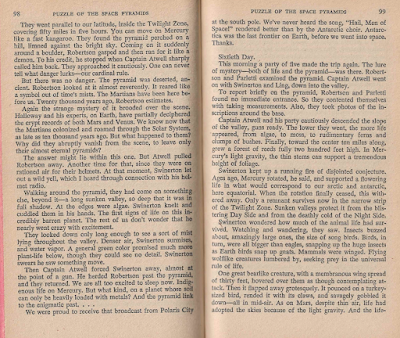The dangerous legacy of ancient astronauts and their dead worlds awaits unwary space explorers in this classic pulp science fiction novel, presented here in a 1971 reprint with a shocking tabletop tableau cover. Our spaceman looks absolutely apoplectic at his predicament! Space Pyramids was a "fix-up" novel, chaining together a series of short stories published in Thrilling Wonder Stories beginning in 1937 and finishing in 1942. Eando Binder was a pseudonym used by one Otto Binder and his brother Earl, hence the nom de plume E-and-O. The Binders were pulp writers in the 30s, and Otto continued on to become a titan of the comics industry:
From 1948 to 1969, Binder wrote stories for the entire Superman line. During his tenure on the Superman titles, he co-created such characters and concepts as Supergirl, Brainiac, Kandor, Krypto, Streaky the Super-Cat, Beppo the Super-Monkey, Titano the Super-Ape, Lucy Lane, Jimmy Olsen's signal watch, the Imaginary Story, and the Legion of Super-Heroes.
Binder would later pen some "nonfiction" Ancient Astronaut/UFO books near the end of his life, but this pulp fiction from decades before contains all the ingredients needed for the craze that eventually exploded after von Daniken. The precedents are so strong that some Ancient Astronaut proponents are even convinced that Binder, like Lovecraft before him, actually had access to the dark secrets of our alien past and filtered this knowledge through their fiction! Go figure.
Binder writes coolly, mostly avoiding the aw shucks, gee whiz quality that can often date this era of SF. He raises a frisson of dread with his eerie Martian ruins, and his Venus is the classic pulp vision of a world drowned in foetid swamps and riot with life. In a scene worthy of the goriest Italian sci-fi, an astronaut's wound almost instantly sprouts a deadly fungus that quickly consumes his entire body! In the end the solution to the titular puzzle is classic Chariots drama, simply handled by a writer far more capable than that hack von Daniken. As a bonus, the new cover art launches this classic pulp straight into the Space Age, soaring past its Johnny-come-lately imitators. Recommended!
3/4
Curtis Books, 1971 (original pub. 1937)










No comments:
Post a Comment